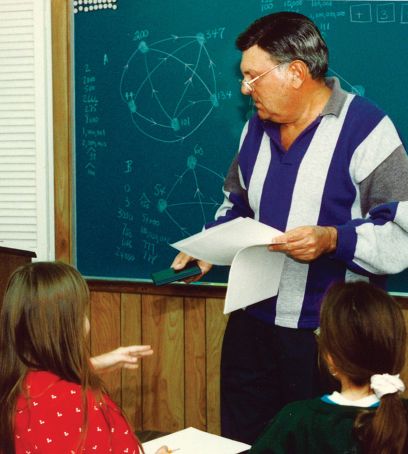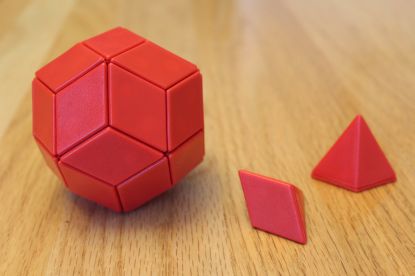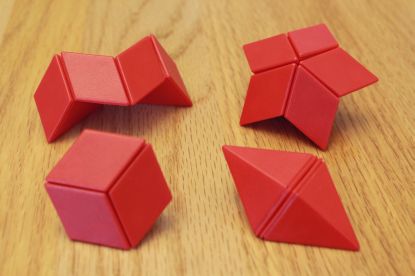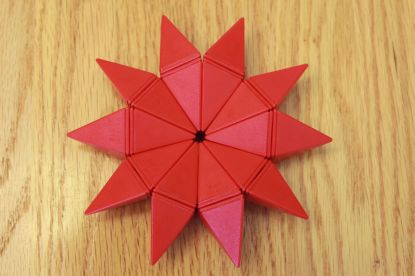
during an engaging mathematics lesson (c. 1996).
In our previous IMACS blog post, we began our response to Professor Andrew Hacker’s op-ed piece entitled “Is Algebra Necessary?” by taking a critical look at his reasoning in favor of eliminating the requirement for high school algebra. We argued instead that the approach to teaching algebra, and more broadly all of mathematics, should be changed significantly in the US to benefit all students, from those who are struggling to ones who are at maximum achievement under the current limited system. In this week’s post, IMACS discusses key elements that we believe should be part of any effective curriculum in mathematics.
We were pleased to see that Prof. Hacker quoted mathematics professor Peter Braunfeld of the University of Illinois as saying, “Our civilization would collapse without mathematics.” Prof. Braunfeld is not new to the mathematics education debate, having co-authored an article* on the subject with IMACS principal founder, Burt Kaufman, and IMACS curriculum contributor, Professor Vincent Haag, nearly 40 years ago. (Prof. Braunfeld was also a contributor to the IMACS curriculum.) Their article outlined five principles that have and continue to guide IMACS in our curriculum development.
Everything Old is New Again
A 40-year-old article!? How can that be relevant now? Sadly, the circumstances lamented then by the co-authors remain a plague on our US math curriculum to this day. Have you heard anything like the following excerpts lately?
On the mindless drudgery that passes for school mathematics: “A student has simply been shortchanged if after nine to 12 years’ study of mathematics, he leaves school with the notion that mathematics consists of a large collection of routine and boring algorithms that enable him to get ‘correct answers’ to certain, usually contrived, questions.”
It’s no wonder that students find math dull and tedious. The trivialized curriculum forced upon them has been stripped of all the wonder and beauty of mathematics.
On technology as the cure: “Some educators appear to believe that the basic problem lies not in the meager and often irrelevant content of school mathematics but in the inadequacy of the delivery systems. … [I]t is surely putting the cart before the horse to concentrate on improving delivery systems without at the same time making a concerted effort to improve and reorganize the mathematics that these systems are to deliver.”
In just the past year, the articles we’ve read suggesting that video tutorials, massive open online courses, and the iPad are going to “revolutionize” education are too many to count. The drive-thru window may have changed how Mickey D’s was served, but the stuff in the paper bag remained of questionable nutritional value for a long time. (Yet even the Golden Arches eventually overhauled its menu!)
Describing the approach then referred to as “behavioral goals”: “As we understand it … we must first very carefully set down our aims—just exactly what we expect the children to know at each stage in their progress. … Once this is done, materials can be produced that explicitly address themselves to the stated aims. Periodic tests and checks should be administered to determine whether the children have met the prestated behavioral goals, i.e., they can indeed ‘do’ the things that the materials purport to teach.”
Can we say teach to the test? The idea of “industrialized education” came about long before No Child Left Behind. What’s unfortunate is that such an ill-conceived notion wasn’t what was left behind.
Five Guiding Principles of Mathematics Education
So what are the five guiding principles that the co-authors proposed? The excerpts that follow summarize how they believed mathematics should and can be taught to children and how IMACS teaches today:
“1. Mathematics is an important intellectual discipline—not merely a collection of algorithms for performing calculations. One of the primary aims of a good mathematics curriculum should be to exhibit mathematics as a method of inquiry that enables us to answer interesting and important questions. We will never achieve this aim if we set our sights so low that we teach only the trivial—we must not, for example, become obsessed with teaching only algorithms.”
“2. The subject-matter of mathematics is ideas, not notation. … [T]he unfortunate fact is that more often than not mathematics is presented to children as if it were the study of certain kinds of printed marks on paper. A good example is the standard treatment of polynomials in high school algebra: students are told that polynomials are ‘expressions of a certain form’ and are then simply given a number of rules on the ‘proper’ way to ‘manipulate’ such expressions. We submit that if mathematics is presented as a subdiscipline of typography, it cannot play a significant role in the intellectual life of children.”
“3. Mathematics is an organized body of knowledge. … A mathematics curriculum has not done well by a student if it leaves him with the impression that mathematics consists of a myriad of unrelated bits and pieces. … If we are to present mathematics to the student as a coherent whole, we shall first have to become clear on what is fundamental and central to the discipline and what is peripheral. The fundamental ideas should be introduced to the student as early as possible so that they can then serve to unify the entire curriculum.”
“4. Mathematics gives us understanding and power over the ‘real’ world. … [T]he power of mathematics to give us solutions to ‘real’ problems is certainly not well exhibited by the stilted and artificial ‘applications’ we actually see in most curricula. … What we must provide, rather, is a wide variety of situations and problems with genuine life and spirit in them—problems that engage the student’s attention and arouse his curiosity. Surely a problem is ‘practical’ for a child if, and only if, it is one to which he would really like to know the answer.”
“5. Mathematics is a form of artistic expression. … A mathematics program that takes the poetry out of mathematics is a bad program for the simple reason that mathematics, like poetry, music, painting or dancing, deals in aesthetic values. … Nothing can replace the importance of a child’s pleasure in seeing an elegant piece of mathematics or, even better, in creating a piece of mathematics for himself. Learning mathematics and doing mathematics may at times be hard work, but it must never become mere drudgery.”
Exasperated students continue to ask when they are ever going to need high school math in the real world, and who could blame them? Yet you never hear such broad and fervent protest about high school science even though relatively few kids will put that knowledge to work. Why less complaining? Because science curricula, for the most part, still incorporate grand ideas that elicit awe in young minds. Why are parents appalled by cuts in the arts at school? Not because most think their kids will pursue careers in creative fields, but because they understand that the aesthetic experience lifts the human spirit.
Mathematics is brimming with this kind of elemental beauty too. Yet decade after decade, schools use curricula that deprive math students of the good stuff. It’s like feeding the cardboard box instead of the cereal to a kid and saying “See, it says ‘cereal’ right there on the label. How can you say it’s tasteless?” Children have been telling us for too long that we need to change the menu. It’s time we listen.
*”Mathematics Education: A Humanist Viewpoint,” Braunfeld, Peter, Burt A. Kaufman, and Vincent Haag, Education Technology, November 1973.
Editor’s Note: IMACS will soon be rolling out a series of interactive online math courses designed with the five guiding principles discussed above. These courses will allow talented students to complete all of middle and high school mathematics with the exception of calculus before leaving middle school. Check back at www.eimacs.com or like us on Facebook for exciting details to come!
Andrew Hacker, emeritus professor of political science at Queens College, City University of New York, recently wrote an op-ed piece in The New York Times entitled “Is Algebra Necessary?” His opinions caused quite a stir in the ongoing debate over mathematics education in the US. IMACS sees value in some of his ideas, such as teaching quantitative reasoning starting in kindergarten, and we agree that schools should not subject students to the “ordeal” of struggling with algebra. However, IMACS believes that education professionals should focus on changing the way mathematics is taught, not on eliminating the requirement to study algebra.
First, consider the attendant consequences of the author’s proposal, which is to create alternative math courses that “familiarize students with the kinds of numbers that describe and delineate our personal and public lives.” Perhaps the large yet still minority percentage of students who cannot pass traditional algebra would be allowed to satisfy their high school math requirement with these alternative classes. As the author sees it, this would limit “misdirecting precious resources” presumably by redirecting them to the new classes. Does that mean we abandon the majority of students who can pass traditional algebra to the ineffective mores of a failing system (now with even fewer resources) because, hey, at least they’re not struggling? Never mind the fact that neither are they soaring as high as they could and will need to as the influence of technology on their world grows!
Teaching mathematics effectively to all students is the outcome we should be striving toward. Make no mistake—we understand the consequences of the prolonged economic stress on families, school districts, and public higher education. It is natural in such times to direct limited resources to activities most likely to lead to gainful employment. So let’s consider a key element of the author’s argument—that high schools are not even teaching students the math skills they will need in the workplace. He writes:
“Nor is it clear that the math we learn in the classroom has any relation to the quantitative reasoning we need on the job. John P. Smith III, an educational psychologist at Michigan State University who has studied math education, has found that ‘mathematical reasoning in workplaces differs markedly from the algorithms taught in school.'”
The author seems to miss the point that the mathematical reasoning skills needed to succeed in the workplace are the same ones needed to succeed in algebra. In both cases, you must be able recognize a problem or challenge, gather information relevant to finding a solution, analyze and synthesize the information to derive a solution, and effectively apply the solution. This takes critical thinking and logical reasoning abilities, and the current pedagogical approach is to try to impart these skills through the process of teaching algebra, almost as a side-effect.
Were the US education system to focus more in elementary school on building these fundamental skills, not only would students find learning high school algebra (and learning in general) easier, they would also be better equipped to succeed in the workplace where problem solvers are highly valued. Furthermore, as learning algebra becomes easier, it becomes less time-consuming, thereby freeing up instructional time to add topics from skill-training to more advanced math as desired. It may sound like an idealistic vision to the millions of people who have come to believe they are “bad at math” when they are more likely the product of bad math curricula, but we have seen this approach work for IMACS students for over 20 years.
“Even in jobs that rely on so-called STEM credentials — science, technology, engineering, math — considerable training occurs after hiring, including the kinds of computations that will be required.”
Of course considerable training occurs after hiring in STEM fields! The need for accuracy and the complexity of the body of knowledge are so much greater in these fields than in others that are more subjective in nature (e.g., the arts) or that rely more on so-called “soft skills” (e.g., politics). We need only to look to the history of the Space Shuttle to understand the consequences of errors in judgment. On a happier note, consider that the successful entry, descent, and landing of the Mars Science Laboratory was almost 10 years in the making. On-the-job training is necessary in many non-STEM fields from law to portfolio management to journalism to costume design. Why should we expect STEM be any different?
“Toyota, for example, recently chose to locate a plant in a remote Mississippi county, even though its schools are far from stellar. It works with a nearby community college, which has tailored classes in ‘machine tool mathematics.'”
As for the Toyota-sponsored Machine Tool Mathematics class, the course catalog description is “An applied mathematics course designed for machinists which includes instruction and practice in algebraic and trigonometric operations. (2 hour lecture, 2 hour lab).” That doesn’t sound like the math is different from what is taught in high school. Rather it sounds more like the way the math is taught is different. With a hands-on lab, it actually sounds like fun! That is a huge distinction and goes back to our main point that we need to significantly change our approach to how we teach mathematics in the US.
At IMACS, we support the idea of schools using math curricula that accurately incorporate real-world examples that students care about. This approach helps put abstract concepts in context but, more importantly, gets students interested in learning and helps them understand how mathematics shapes our world. Those who appreciate mathematics in its pure and abstract form are pretty special people, but math should and can be accessible to the majority as well. There also need to be more options for visual-spatial learners who may not “get” math concepts when presented on a bland white board. Rather than redirecting limited resources to creating new alternative classes, the focus should be on redesigning the algebra curriculum (as well as those for elementary, middle, and the rest of high school math) to present mathematics for what it truly is, a deep discipline centered around simple but beautiful ideas, rather than a bunch of numbers, funny symbols, and boring algorithms.
The IMACS Blog has recommended several games, puzzles, and apps that encourage structured mathematical or computational thinking. We’ve also noted the benefits of unstructured time for creativity and for inspiring insightful problem solving as supported by a 2009 study on wandering minds. This week’s blog brings together these two ideas with a look at a puzzle called the Ball of Whacks. This toy was recommended to us by an IMACS alumna whose daughter is enrolled in our Primary Enrichment math class, so we have it on good authority that the Ball of Whacks is a winner!
What Is It?
The Ball of Whacks is a puzzle that consists of 30 magnetic pyramids, which the inventor calls “Whacks.” When you open the package, the 30 pieces are held together by internal magnets in the form of a ball-like, 30-sided rhombic triacontahedron. Give the “ball” a good whack and it will break apart so that you can play with the pyramid pieces.
What makes these pyramid pieces so special? Each is a right golden rhombic pyramid! (We math geeks tend to have a natural appreciation for toys such as this one.) As the mini-book that comes with the Ball of Whacks explains:
Space Out
Whether you’re an aficionado of this special polyhedron or what you’ve read above is enough to satisfy your mathematical curiosity, we think you will enjoy playing with this toy in several ways. After breaking the puzzle apart, your natural first instinct may be to figure out how to put it back together. Although this won’t be challenging for most of our blog readers, we think you’ll still find it satisfying if you enjoy the simple beauty that mathematics often presents.
With that out of the way, you might find yourself casually shifting puzzle pieces around without much physical effort or purposeful direction. Then in what seems like a sudden moment, they come together in one of many interesting shapes or patterns. The experience is reminiscent of doodling as a way of relaxing and unleashing your subconscious. This kind of unstructured play feels uncannily like a physical representation of a wandering mind that experiences sudden insight in solving a problem.

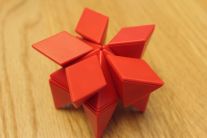
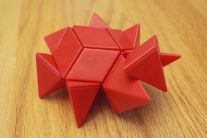

Creative Design
When you’re in the mood to solve a well-defined problem analytically, pick one of the more than 20 shapes in the mini-book and try to make it yourself. Then think outside the book and create your own design. If you enjoy tangrams, then you’ll probably enjoy playing with the Ball of Whacks in this way. Don’t forget that the pyramid pieces are magnetic, so you can create designs on any metallic surface such as a refrigerator door or magnetic white board.
In addition to the shape challenges, the mini-book also contains 15 exercises that make up what is called a “creativity workshop.” For example, Exercise 4 asks you to drop your assumptions about how you play with the Ball of Whacks. As the book explains:
The exercises make for an interesting casual read. They may even help parents begin discussions with children that end up leading to creative thinking. Given that different minds get stimulated by different types of experiences, it’s hard to say definitively that this particular toy will enhance your creativity. However effective the Ball of Whacks is as a creativity tool for a given individual, one thing is certain: the Ball of Whacks is a fun toy for unstructured play, which is widely understood to be good for creativity.
Geometric Gem
The Ball of Whacks can be had for about $25 online through retailers like Amazon. Some might balk at what seems like a high price for a “simple” toy; however this seems to be in line with the price for magnetic “thinking” toys such as Magna-Tiles and Geomags. For a mathematically inclined mind, the Ball of Whacks can be loads of fun!







